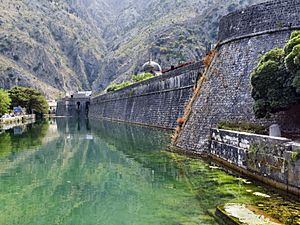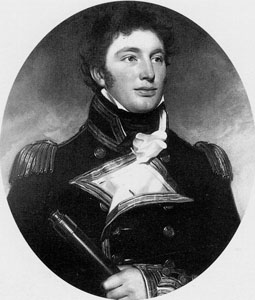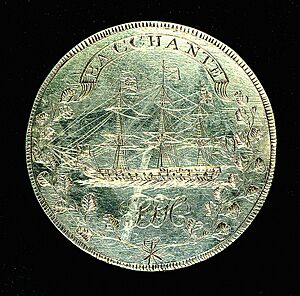Siege of Cattaro facts for kids
Quick facts for kids Siege of Cattaro |
|||||||
|---|---|---|---|---|---|---|---|
| Part of the Adriatic Campaign of the Napoleonic Wars | |||||||
 View of Cattaro (present day Kotor) from the castle of St. John |
|||||||
|
|||||||
| Belligerents | |||||||
| Commanders and leaders | |||||||
| Strength | |||||||
| 800 1 frigate 1 Brig 3 gunboats |
600 | ||||||
| Casualties and losses | |||||||
| 20 killed and wounded | 600 captured | ||||||
The Siege of Cattaro was an important battle during the Napoleonic Wars. It took place in a strong mountain fortress called Cattaro, which is now known as Kotor in Montenegro. British naval forces, led by Captain William Hoste and Captain John Harper, teamed up with Montenegrin fighters under Petar I Petrović-Njegoš. They fought against the French soldiers defending the fortress, led by Jean-Joseph Gauthier.
The siege lasted for several months, from October 14, 1813, to January 3, 1814. It was part of a larger fight called the Adriatic Campaign. The goal was to take control of this key fortress in the Adriatic Sea. In the end, the British and Montenegrin forces won, and the French surrendered.
Contents
Why Cattaro Was Important
Cattaro had a long and interesting history. For many years, from 1420 to 1797, it was part of the Republic of Venice. After that, it was taken over by the Austrian Empire.
In 1805, during the Napoleonic Wars, Cattaro was given to France's ally, the Kingdom of Italy. However, Russian troops occupied it for a few years. They left in 1807. Three years later, Cattaro became part of the French Empire's Illyrian Provinces.
By August 1813, Austria declared war on France. The British Royal Navy gained control of the Adriatic Sea. This allowed them to move troops quickly. They helped Austrian armies take back important ports like Zara.
The British and Montenegrin Plan
Captain William Hoste of the British Royal Navy was given a mission. He was to remove the French from the region. His ship was HMS Bacchante, a frigate with 38 guns. He was joined by Captain John Harper on HMS Saracen, a smaller brig-sloop with 18 guns.
They first helped capture the islands of Hvar and Brač. Then, they set their sights on Cattaro. Montenegrin troops, led by Petar I Petrović-Njegoš, had already surrounded the fortress. Petar I was a respected spiritual and military leader.
Captain Harper's ship, Saracen, arrived first at the Cattaro Bay. It was hard to sail directly to the fortress. So, local people helped tow the ship along the rocky shore. Soon after, Captain Hoste arrived with Bacchante and three Sicilian gunboats. These gunboats carried 50 soldiers. Hoste took command. The British and Sicilians fought their way into the bay. They found a safe place to anchor about three miles inside.
Starting the Siege
On the evening of October 14, Captain Harper took action. He went into the inner bay with two gunboats and other small boats. They were fired upon from the Island of St George. Harper continued towards Cattaro. He found four French gunboats whose crews were rebelling. He quickly took control of these boats. He then landed in different places. Local people were arming themselves against the French. Harper gathered volunteers to crew his newly captured gunboats.
At a place called Perast, Hoste found that locals had taken a French fort. It had three guns, which they offered to the British. They even raised the English and Austrian flags. At 6 AM, Hoste used these guns, his own gunboats, and the newly captured ones. They began to bombard the Island of St. George.
Within 15 minutes, Royal marines and Sicilian soldiers attacked. Led by Captain Harper, they seized four French gunboats near the island. The next day, the British boats attacked the island itself. They captured it and placed soldiers there. This helped them block off Cattaro. The captured gunboats were useful. Each had a large 24-pounder cannon. Two of them also had 12-pounder carronades.
The Difficult Blockade
Now, only the main Cattaro fortress remained. Hoste, Harper, and their allies surrounded the area. These allies included British, Croats, Montenegrins, and Sicilians. Hoste faced a tricky situation. The Montenegrins had strong support. But the local people who were pro-Austrian did not want to be ruled by Montenegro.
Hoste tried to stay neutral. His main goal was to defeat the French. However, he knew politics would become important later. He also wanted to please the British commissioner, Lord Aberdeen. This meant trying to ensure the Austrians would gain control of the area.
Hoste was ordered to attack other places for a while. Harper was left in charge with Saracen. Hoste helped capture Split with British troops. For the next month, Cattaro was closely blockaded. Everyone hoped Austrian troops would arrive. Bad weather made things difficult. Hoste captured Cavtat further north. He then returned to Cattaro Bay, but no Austrian troops had arrived.
The Final Attack
By early December, the French commander, General Gauthier, had retreated. He and his 600 men were inside Fort St. John. This fort was on the side of a hill. It protected the western part of Cattaro. Hoste and Harper decided to use the local armed people. They would help in the final stages of the siege.
They planned to place cannons all around Cattaro. A key spot was the very top of the St. John hill. This was right above the fortress itself. Hoste and Harper led their men in a very hard task. They had to move cannons up the steep, difficult slopes of the Cattaro hills. They used ropes and pulleys.
Despite continuous rain, the sailors worked for three weeks. On December 23, an 18-pounder cannon was hoisted to the summit. This was nearly 3,000 feet high! Meanwhile, Bacchante and its crew set up more cannons. Two batteries of 18 and 32-pounders were added. Hoste, even though he was sick, personally helped his men. He moved equipment up the mountain slopes.
On Christmas Day, the weather improved. All the cannons were in place. Hoste ordered the bombardment to begin. Fire came from four different points. The 18-pounder above St. John fortress was especially effective. Saracen and Bacchante stayed out of range at first. But once the shelling started, they fired all their guns.
On January 2, Hoste ordered Harper to lead a surprise night attack. But this attack wasn't needed. On January 3, 1814, as Harper was preparing the assault, General Gauthier offered to surrender. After ten days of heavy shelling and no hope of help, the French gave up. They surrendered to Hoste under honorable conditions. The British and Montenegrins took control of the fort and the town.
What Happened Next
The British had very few losses. Only one sailor was killed, and a marine officer was slightly wounded. Hoste had hoped for Austrian soldiers to arrive, but they didn't. Hoste signed the surrender agreement. The French and Italian troops marched out. Then, British and Montenegrin troops marched in.
Hoste gave the town to the Montenegrin leaders. This made Lord Aberdeen unhappy. But Hoste explained that he had no other choice.
After a short rest, Hoste and his ships, Bacchante and Saracen, left Cattaro. They sailed to the fortress of Ragusa. They laid siege to Ragusa in a similar way to Cattaro. Ragusa surrendered on January 28. By the end of March, almost all towns and cities had surrendered. The British or their allies controlled the Adriatic Sea. Cattaro was later returned to the Austrian Empire by the Congress of Vienna.
See also
- Fortifications of Kotor




